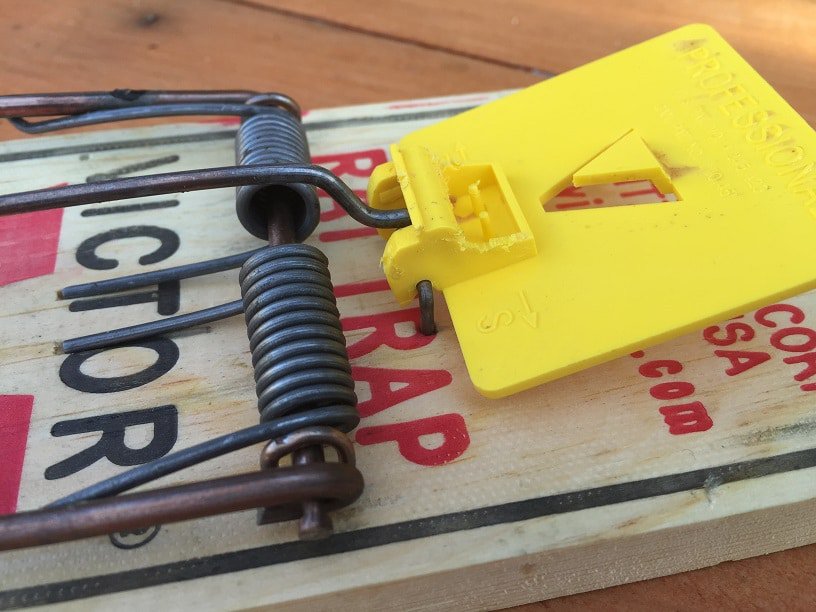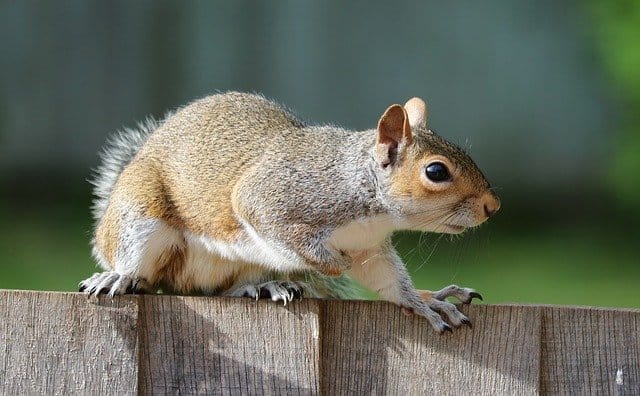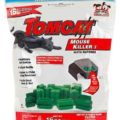Table of Contents
To most people, squirrels are those cute, little skittish creatures you see scurrying up a tree to safety while you walk your dog in the morning or drive your car down the road.
However, these furry beasts become a lot less cute when they’re taking up residence in your attic rent-free.
They have all the characteristics of an unwelcome guest: damaging your things, making noise late at night when you’re trying to sleep, and they just won’t leave.
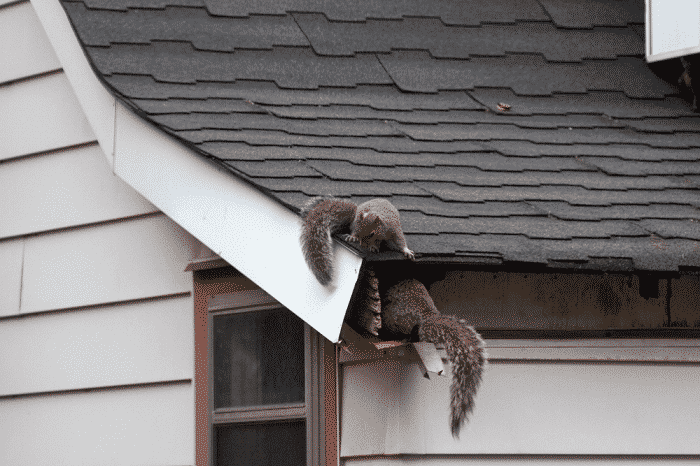
If a squirrel—or possibly a few squirrels—have made themselves comfortable in the attic of your home, it can be difficult to know how to lead them out.
You don’t want to get too close to them for fear of getting bitten and catching one of many diseases they could be carrying, including deadly ones such as rabies.
So, without further ado, let’s dive into everything you need to know about how to get rid of squirrels in the attic:
Know Your Enemy| Do You Have Squirrels Or Roof Rats?
To begin with, you’re going to want to confirm that it really is squirrels in your attic you’re trying to contend with.
It’s common for people to think that they have squirrels living in their attic when in reality, they are roof rats. Here is how you tell the difference:
- Rats are active at night, while squirrels are active during the day.
- Rats leave trails of urine and droppings everywhere they go. Squirrels, on the other hand, are far neater and tend to leave their droppings in a single area.
- Rats in the US are a regional problem. If your place of residence isn’t common for roof rats, then your unwanted guest is likely a squirrel. If you think the problem is rats, click here for help!
- This is less common, but if the critter is not a squirrel or a rat, then you might be dealing with a raccoon. You can tell if it’s a raccoon based on its paw prints (they’re flat-footed with 5 toes). In addition, they make a lot of noise while lumbering around your attic—far more than a rat or a squirrel.
Once you’ve confirmed that the animal plaguing your attic really is a squirrel, it’s time to go about getting rid of it.
Is It Really A Problem To Have Squirrels In Your Attic?

When a furry little tree squirrel makes its way into your home through loose siding or otherwise vulnerable areas, it’s easy to ask yourself if it’s really a problem.
Because they are so small in size, they are prone to making nests in places like attics.
Another reason they like attics is that they are typically dry, warm, and uninhabited for the most part.
You might be thinking, “But squirrels are cute. What’s so wrong with letting these guys make a home in my attic?”
Well, once they have settled into their nest, squirrels will normally then proceed to chew on insulation and the insulation around wires, which can short out transformers or even cause fires.
Not to mention, they can carry diseases and even deadly ones like rabies. And if you’re like the countless people who use their attics for storage, then these squirrels can end up damaging your belongings.
DIY Or Hire A Pest Removal Company?
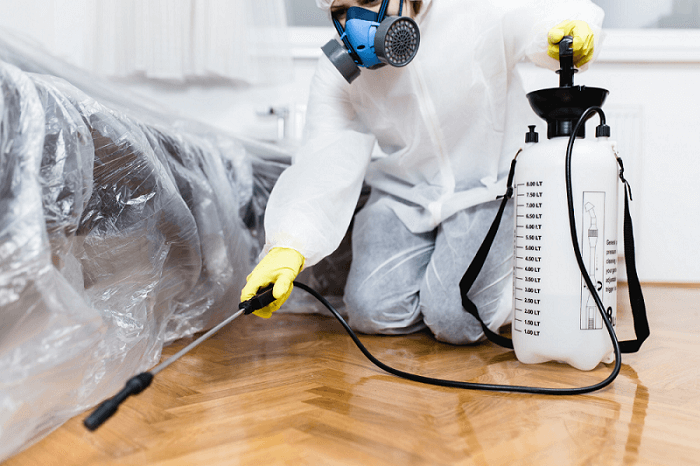
In the process of trying to get these critters out of your attic, it’s easy to think that you can make the problem go away with a quick and simple call to a pest removal company to help you with squirrel control.
And in many cases, that’s a great idea (especially if you’re dealing with a squirrel that you believe may have a disease or a defensive mother squirrel).
Thinking of hiring a pest removal company instead of taking care of the problem yourself?
Here are some pros and cons of that choice that might help make it easier to make that decision.
Pros Of Hiring A Pest Removal Company
- Quick and easy
- You don’t have to think about it
- Ideal option for those who are skittish about animals
- Best if you think the animal may have a disease or if baby squirrels and their mother are involved
Cons of Hiring a Pest Removal Company
- Hiring a professional is more expensive
- You need to wait for the pest removal company to be available
Working with pest removal is usually a quick process, depending on how busy the pest removal company is. In addition, the cost will probably run you between $250 – $500. When looking for quotes, it’s a good idea to ask if the cleanup of squirrel droppings is included in the estimate.
Do It Yourself Options
Squirrel Traps
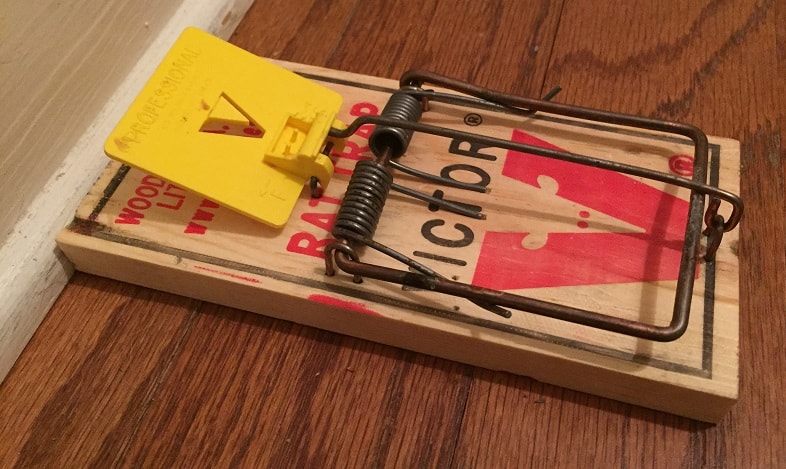
You may choose to trap the squirrel that has taken up residence in your attic to reclaim the space as your own. Here’s everything you need to know about squirrel traps.
Humane
There are plenty of humane options to trap squirrels. Squirrel traps are available that allow you to lure the critter in with bait, and the door shuts behind them, allowing for relocation.
Lethal
We recommend not using lethal methods of trying to trap squirrels. For one thing, it is inhumane, and you don’t want to risk killing the squirrel, especially if there is a chance you are killing a mother squirrel.
Not to mention, killing squirrels is often illegal.
Another thing to consider is that you’ll then have the carcass to deal with.
It will quickly begin to decompose and smell, which poses health risks to you and your family. Plus, you probably don’t want to have to find a way to dispose of the dead body yourself.
Set Your Trap
Use a small, live cage trap. It should be set in a corner of your attic or another safe, hidden area.
Squirrels will be more likely to approach it if it is positioned somewhere out of the way instead of in the middle of open space.
Use smaller traps, as the squirrel may panic and hurt itself in a larger trap.
Generally, a trap of 6 inches by 6 inches by 16 inches is ideal, and these large cage traps are usually available for purchase at hardware stores.
Depending on the trap you buy, it may need to be set up a little differently. You should read up on the instructions in order to be sure you are setting it up correctly.
Typically, you will be required to place a swing bar trigger mechanism in a particular way. This allows the trap to be “tripped” once the squirrel makes its way into the cage, closing and locking the door.
Put Out Your Bait
Your unwelcome guest won’t want to enter the trap you have set up for it if you haven’t given it adequate bait to lure it inside.
Squirrels aren’t going to go near your painstaking set-up trap unless there’s food inside, and it’s appetizing.
Some good options include peanuts, peanut butter, soda crackers, walnuts, bread crusts, or apple slices.
Finally, ensure that the food is in a position within the trap that will prevent squirrels from grabbing it through the side of the cage without getting trapped inside.
Relocate The Squirrels
After trapping your squirrel, or possibly multiple squirrels, you will want to move it away from your home.
Putting about 10 miles of distance between your home and the squirrel is typically a good rule of thumb to discourage them from coming back to your home.
Simply moving the squirrel to your yard isn’t enough, as it will often try and find a way to get back inside.
Before you drive away with the squirrel inside the trap, thoroughly check your attic for baby squirrels.
It’s possible that you trapped a mother squirrel, in which case, her little ones would be helpless without her.
If you do find any baby squirrels, make sure that they are relocated along with their mother.
Wear heavy, thick gloves for when you release the squirrel from the trap. It may seem angry or irritated. If that is the case, you can release it from a distance if you attach a rope or cord.
Pulling it from far away would allow you to release the mechanism.
Before doing this, you may want to check the laws in your area regarding animal relocation.
Most of the time, trapping and relocating squirrels is not a problem, but this is not the case in every county or city.
Repeat The Process Until Your Attic Is Squirrel-Free
By doing this once, you may not have removed all the squirrels from your attic if you have more than one in there.
By repeating the process until all the squirrels have been relocated, you should be able to rid your attic of all squirrels.
To prevent the need for squirrel removal in the future, you should patch up any entrances to your attic that the furry critters could be entering from.
One-Way Squirrel Doors
One-way squirrel doors are another extremely popular method to rid one’s attic of squirrels.
This involves setting up a way for the squirrel to be able to get out of the attic, whether to get food and return or because it’s responding to a repellent in your attic.
However, once they are out of the attic, they will not be able to re-enter through the one-way squirrel door you have set up. Want to set one up yourself? Here’s how:
Seal Off the Attic
Your first step toward getting rid of squirrels in your home is going to be to seal off the attic.
This is something you may not have expected (What if the squirrel wants to get out on its own?) but it is a crucial step.
In many cases, the squirrel won’t be able to find its way back outside even if it wanted to, and at that, why would it want to?
You’re keeping them warm and comfortable right where they are, and they’re probably not in a hurry to pack their bags and leave.
You will want the squirrels to leave through a hole eventually, but you’ll only want to leave one hole uncovered to facilitate this. We’ll get there in a minute.
Another reason it’s important to seal off your attic is so you don’t attract any more squirrels.
After all, you don’t want the current inhabitants already there to invite their friends and start throwing a house party—where you’re left to clean up the mess when they start ripping into the cardboard boxes you have stored in your attic.
To seal off your attic, you can start by placing a wire mesh fencing or chimney cap over your chimney.
From there, cover any vents with wire mesh fencing and patch up any chewed-out holes leading to the outside of the home.
However, you’ll want to leave one hole uncovered. This allows you to fashion an exit for the squirrels. Once the problem stops, though, you’ll want to cover this hole as well.
Next, secure any openings in the attic that lead into the rest of your home.
If a squirrel realizes that an attic is no longer a welcome place for them to live, they may scurry even deeper into your home.
Setting The One Way Door
Now, you should have an attic that is sealed off against the rest of your home as well as from the outside (save for a single hole). .
After you have done this, it’s time to create an exit for the squirrel.
Use fine wire mesh or a sheet of metal to create a funnel and attach the narrow end to the hole leading outside.
The funnel’s wide end should be placed over the hole on the outside of your home. It should be about 12-15 inches wide, and the entire funnel should be around 1 foot long.
The narrow end of your funnel should extend out further into the outside and it should be approximately as wide as the hole in the woodwork, if not a little bit smaller.
Once this is done, squirrels will typically be able to find their way inside through the funnel and find their way out.
Drawing Them Out
To get the squirrel to enter the trap you’ve so carefully created, you’ll want to make the space outside the funnel smell appealing by placing food near the narrow mouth of the funnel.
If you don’t, they may leave on their own to gather food, but they will probably leave faster if you draw them out with food like apple slices or peanuts.
Once they’re drawn out through the trap, they shouldn’t be able to get back in.
Squirrel Repellants And Deterrents
The use of squirrel repellents and deterrents is another popular way to rid your attic of squirrels and to prevent them from coming in again or at all.
One important distinction to make between these two solutions is that a repellent makes nesting squirrels want to leave the attic, while deterrents make new squirrels not want to enter the attic in the first place.
So, if you already have these unwelcome guests calling your attic home, you’re going to want to opt for a repellent.
Do-It-Yourself Repellents And Deterrents
Here are some helpful options you can implement to get squirrels out of your attic and prevent them from entering it at all.
Scare Them Using Sound
Turn on a radio in the attic and leave it there, or use an ultrasonic repellent in your attic to frighten the squirrels into leaving.
If you opt for the radio, you’ll want to keep it on a talk station. This way, the squirrels will constantly be hearing human voices.
It need not be loud enough for you to hear it, but it needs to be loud enough that the squirrels can hear it. The use of the radio technique will be limited, however, if the squirrels in question are accustomed to being around humans.
Ultrasonic repellents, on the other hand, produce a high-decibel noise that can only be heard by small animals. This will make being in your attic unbearable for squirrels once you first turn it on.
However, squirrels can learn to adapt to the noise and settle in overtime. In addition, if you have other animals in your home, this might bother them too despite the fact that you can’t hear them.
Flash Lights
Install flashing strobe lights in the attic, or simply leave the light on in the attic.
These may help to discourage the squirrel from getting too comfortable in your attic and encourage it to leave to go elsewhere and build its nest.
Commercial Squirrel Repellent
Another option is using commercial squirrel repellent. You can purchase one from a manufacturer and apply the spray to your attic according to the instructions on the label.
It’s a good idea to try a type of animal repellent made with predator urine, as it is fairly non-toxic and preys on the squirrel’s sense of smell and self-preservation.
If a squirrel is getting a whiff of a natural predator, they learn to avoid the area.
Do Not Use Poison Or Glue Traps
We highly recommend against using poison or glue traps. Poison is actually illegal, and it results in an unbearable stench.
In addition, glue traps are inhumane and ineffective at killing the squirrels.
All in all, it is best to stick with humane, non-lethal ways to remove and relocate the squirrel from your attic. It is more ethical, and you get to avoid the stench and the responsibility of dealing with the body.
Exclusion
To keep them out, you’ll want to determine how they got in. You’ll want to search your house for the entry holes that these tiny creatures could have squeezed in through and covered them with wire mesh.
Other measures you can take to prevent squirrels from making their way into your home include trimming trees, removing lattices, or other easy-to-climb structures.
The Final Word
While squirrels may be cute, they’re not necessarily cuddly—they’re wild animals, and definitely not “pet material.”
If you find one scurrying around your attic and want to get rid of the nuisance, the best course of action is to try and get rid of it as soon as possible using any of the methods described here or to get in touch with a professional pest removal company to take care of the problem for you.

